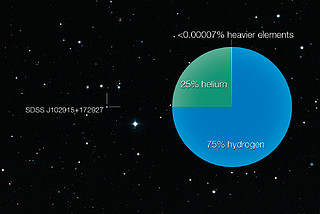An international team of cosmologists has discovered a star with some unusual properties. SDSS J102915+172927 has the lowest concentration of elements heavier than helium (collectively called ‘metals’ by astronomers) ever found. In fact, the star’s ‘metallicity’ is so low that it defies the previously convention for star formation.
Let’s go back in history a bit. Soon after the Big Bang, the early universe consisted of hydrogen, helium and traces of lithium. All other elements were created within stars, and then disseminated throughout the universe as those stars blew up in supernovas. Since stars form by accumulating whatever material is around them, and the very oldest stars only had those three elements to hand, they have a low metallicity. On the other hand, newer stars form from the remnants of supernovas, and have a much higher number of heavy elements. Because SDSS J102915+172927 has almost no metals, it is assumed to be about 13 billion years old, or close to the age of the universe itself.
That’s not the weird part. Not only does SDSS J102915+172927 have almost no metals, but it also has 50 times less lithium than the post-Big Bang universe. Where did the lithium go? Add in the fact that the earliest stars were mostly massive and short-lived, whereas SDSS J102915+172927 is only about 0.8 solar masses and obviously still around, and you have a real mystery.

An ancient star in the constellation of Leo (The Lion), called SDSS J102915+172927, has been found to have the lowest amount of elements heavier than helium of all stars yet studied. The pie-chart shows the star’s composition: it is almost entirely made from hydrogen and helium with only a tiny trace of heavier elements.
Credit: ESO/Digitized Sky Survey 2
No comments:
Post a Comment